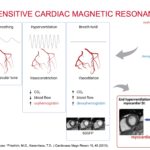Breathing New Life into Cardiac MRI: Oxygen-Sensitive Contrast with SSFP at Low Field
Description: Blood oxygen saturation is an important marker in cardiovascular diseases. T2-sensitive Blood-Oxygen-Level-Dependent MR (BOLD) leverages the paramagnetic properties of deoxygenated hemoglobin as an endogenous contrast mechanism, making it inherently sensitive to tissue oxygenation levels. This technique has been validated with the use of vasoactive breathing maneuvers— which serve as a physiologic contrast mechanism—to detect myocardial venous blood oxygenation changes in both preclinical and clinical studies at higher field strengths (1.5T and 3T). This study explores the feasibility of oxygen-sensitive cardiac magnetic resonance (CMR) imaging at low-field strengths by optimizing a balanced steady-state free precession (bSSFP) sequence. Leveraging numerical simulations and phantom experiments, we aim to establish a robust method for assessing coronary vascular responsiveness, expanding the potential of BOLD MRI beyond high-field systems.
Investigators : Katerina Eyre (CHUV)
Collaborators: Matthias Stuber (CHUV), Jean-Baptiste Ledoux (CHUV), Ruud van Heeswijk (CHUV), Jérôme Yerly (CHUV), Matthias Friedrich (McGill), Elizabeth Hillier (Area19)




